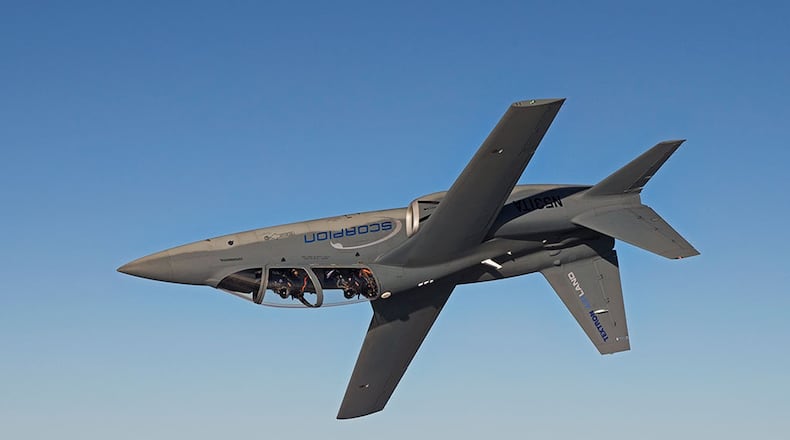Contractors have a deadline of today to submit proposals for the OA-X, as the experimental light attack plane is called, but the Air Force says it will not immediately release the names of the companies.
Cheaper to fly?
The Air Force will investigate if it’s feasible and cheaper to build a commercial “off-the-shelf” light attack plane by the hundreds to fly into less heavily defended air space at less cost compared to flying more expensive jets, such as fast moving F-16 Fighting Falcons, to do the same job, said Jack Blackhurst, director of the Strategic Development Planning and Experimentation Directorate at Wright-Patterson.
“We don’t think this mission is going to go away anytime soon and so there’s going to be a need for this kind of activity, close air support, for some time,” he added. “It’s really a cost argument.”
Textron AirLand was expected to enter the Scorpion jet and sister company Beechcraft has indicated it will enter the AT-6 Wolverine for flight tests, according to a spokeswoman.
Other companies will likely jump in.
“We’re expecting three or four players to play but there could be many more,” said Blackhurst, a retired Air Force colonel.
Aerospace manufacturers will be in a potential high stakes face-off.
“It’s pay to play,” Blackhurst said. “They have to bring their airplanes to Holloman Air Force Base (in New Mexico) and then we’re going to run through a series of …close air support missions where we will have our pilots actually flying those planes.”
Test flights will take flight over the summer. In the future, the plane is expected to be tested overseas. Results will reach Air Force Chief of Staff Gen. David L. Goldfein at the end of the experiment.
A decision on what’s next is targeted by the end of the year. “This isn’t a fly-off, it’s not a competition, there’s no down select involved here at all,” Blackhurst said. “It’s just tell me the data. What’s out there that could work.”
Senator backs plane
Even so, the OA-X has the backing of a key defense hawk in Congress.
In U.S. Sen. John McCain’s white paper “Restoring American Power,” the Arizona Republican said the Air Force needed up to 300 of the planes in tandem with the A-10 Thunderbolt II ground attack jet.
McCain, chairman of the Senate Armed Services Committee, said the nation needs 200 of the new planes by 2022 to fly counter terrorism missions and support ground troops, among future uses in so-called “permissive environments” that lack heavy air defenses.
Today, the Air Force flies the F-16, A-10 Thunderbolt II, the F-15E Strike Eagle and will fly the F-35A Joint Strike Fighter to bomb targets near ground troops in the close air support role, officials say.
“The experiment that we’re talking about is not a replacement for the A-10,” Blackhurst said. “It’s just trying to determine are there more affordable options … to perform the mission.”
At the high end, the fifth-generation stealthy F-35A costs $42,000 per hour to fly, about twice or more the expense of the others, Air Force figures show.
Loren B. Thompson, a senior defense analyst with the Arlington, Va.-based Lexington Institute and a defense industry consultant, was skeptical of the plane’s chances in a future budget and on the battlefield.
“So far all the Air Force has agreed to is they are going to give them a try and see what they find,” he said in an interview. “It’s quite possible this program will never happen at all especially if we don’t get a budget in place.”
The Department of Defense continues to operate at last year’s spending levels under a stop gap measure called a continuing resolution. Congress has not been able to agree on a budget to appropriate money for fiscal year 2017. The current stop-gap funding measure expires April 28 unless lawmakers reach a defense budget deal or extend a temporary spending measure.
Similarly, Democrats and many Republicans are at odds over the Trump administration’s proposed fiscal year 2018 spending bill that would add $54 billion to the defense budget, but cut a similar amount in domestic spending.
Thompson also had doubts how survivable the OA-X, particularly propeller-driven aircraft, might be on a modern battlefield.
“I’m all in favor of using a propeller-driven aircraft if it will work because it will be cheaper,” he said. “I just have a feeling by the time they get this aircraft in the field they’ll be no such thing as permissive air space. Permissive air space doesn’t mean the Russians aren’t around. It means that there’s nobody around that even has a shoulder- fired missile and that just doesn’t seem very likely to me 10 years from now.”
Richard Aboulafia, an aerospace analyst with the Virginia-based Teal Group, echoed concerns about a future light attack plane.
“It’s not the greatest idea,” he said in an email. “These are the sorts of planes they fly in Kenya and Laos. If they encountered any kind of air-to-air or serious ground-to-air opposition, these planes would be destroyed in seconds. And if the Air Force pursues OA-X while simultaneously retiring the F-15C fleet, it clearly indicates that the US is kind of done with being a superpower.”
A Textron AirLand and Beechcraft spokeswoman said in a statement the company was confident the planes “can fulfill the evolving mission needs of the USAF in the modern battlefield.”
The jointly produced Embraer-Sierra Nevada Corp.’s A-29 Super Tuscano was purchased by the Air Force in recent years to train and equip the Afghan Air Force with 20 of the propeller-driven planes to fight the Taliban in Afghanistan.
The U.S. military also flew propeller-powered attack planes in the Vietnam war.
MILITARY NEWS
Follow our military affairs reporter Barrie Barber on Facebook. Get the latest news from him on Twitter at @BarrieBarber
About the Author
